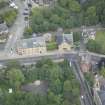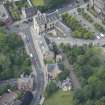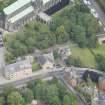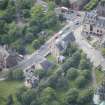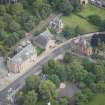Pricing Change
New pricing for orders of material from this site will come into place shortly. Charges for supply of digital images, digitisation on demand, prints and licensing will be altered.
Glasgow, Cathedral Square, Bridge Of Sighs, Superintendent's House
Caretakers House (19th Century)
Site Name Glasgow, Cathedral Square, Bridge Of Sighs, Superintendent's House
Classification Caretakers House (19th Century)
Alternative Name(s) 50 Cathedral Square; The Gatehouse
Canmore ID 246094
Site Number NS66NW 75.03
NGR NS 60235 65491
Datum OSGB36 - NGR
Permalink http://canmore.org.uk/site/246094
- Council Glasgow, City Of
- Parish Glasgow (City Of Glasgow)
- Former Region Strathclyde
- Former District City Of Glasgow
- Former County Lanarkshire
2-storey and attic lodge Tudor gothic style. Main elevation to N single storey due to steeply sloping site with simple symmetrical entrance frontage. Stugged ashlar, polished painted openings with gothic details. Steps to central hoodmoulded doorpiece, architraved door with shouldered fanlight. Single storey projecting range to left with tall diamond cans, slate roofs.
Forms part of David Hamilton's grand processional way from Cathedral Sqaure across the Bridge of Sighs to John Bryce's monumental screen wall at the Necropolis.(Historic Scotland) The Necropolis was the third 'hygenic cemetery' in Britain (following Liverpool's St James, 1829 and London's Kendal Green, 1832) The idea of a garden cemetery, following the model of Pere LaChaise in Paris, had been proposed by a number of leading citizens to the Merchant's House in 1828, suggesting their plantation at Fir Park could be utilised for this commercial use.
The burial ground was intended to be interdenominational, and a Jewish burial ground was established on the north west slope in 1830. The following year a competition was held for the layout of the new cemetery. Although architects were initially appointed, instead the Merchant's House decided that a landscape gardener would be best suited to taking the design forward. George Mylne was subsquently appointed first Superintendent of the Necropolis.
Architectural features were professionally designed, as were many of the monuments, all of which would be vetted after 1835 to "prevent the construction of monuments in very bad taste". Proximity to the Knox monument was considered most prestigious, being sought after by leading families even after the extension of the cemetery to the east into a former quarry in 1857, and further east in 1894. (Williamson, Riches & Higgs)














